COVID-19 Enhanced Outreach - Follow Up Call – No Representative (Unrepresented Claimant/ProSe)
Acknowledgement of Receipt (Notice of Hearing)
CEO Unrepresented Claimants Desk Guide for Follow Up Call
COVID-19 Enhanced Outreach - Follow Up Call – No Representative (Unrepresented Claimant/ProSe)
OMB: 0960-0671

COVID ENHANCED OUTREACH (CEO) DESK GUIDE
Conducting Assigned CEOs – Unrepresented Claimants
Decision writers (DW) will conduct a CEO on cases in Ready-to-Schedule (RTS) or Scheduled (SCHD) status for unrepresented claimants. We are prioritizing cases in SCHD status.
A Group Supervisor (GS) will add a case characteristic (CVEO) and assign a case to Unassigned ALJ Review – Pre Hearing (UNAP) status for the DW to complete a CEO. For cases in SCHD status, the GS will first put the case on SCHD HOLD before assigning the case to UNAP. For cases in RTS, the GS can assign the case to UNAP after the case characteristic has been added.
DW will find assigned cases by running a Workload Listing for cases in UNAP status in CPMS and check for a valid 1696 or other appointment of representation. For reference, the publicly available 1696 form is accessible on the Social Security website, at Claimant's Appointment of Representative. Other publicly available forms related to the disability process are available at https://www.ssa.gov/forms/.
In all cases assigned to a DW in UNAP, DW will first review the file for a potential on-the-record decision. Refer to the detailed step-by-step instructions for completing an OTR review in Section 8) of this Guide.
If the DW recommends a potential OTR fully favorable decision after a review of the evidence in the file, alert management for assignment to a Senior Attorney for further review, and do not proceed with the CEO.
DW will follow the steps in the CEO Encrypted Email Guide Email and attempt to call the claimant to obtain electronic contact information and provide the electronic file in advance of the CEO contact.
DW will then create a Report of Contact (ROC) for each SSN via DGS by selecting Correspondence, then Other, then Report of Contact. The DW can then associate the ROC with the claimant’s SSN, select Done, and save the ROC to his or her folder on the shared drive. The following is an example of a ROC generated using DGS:
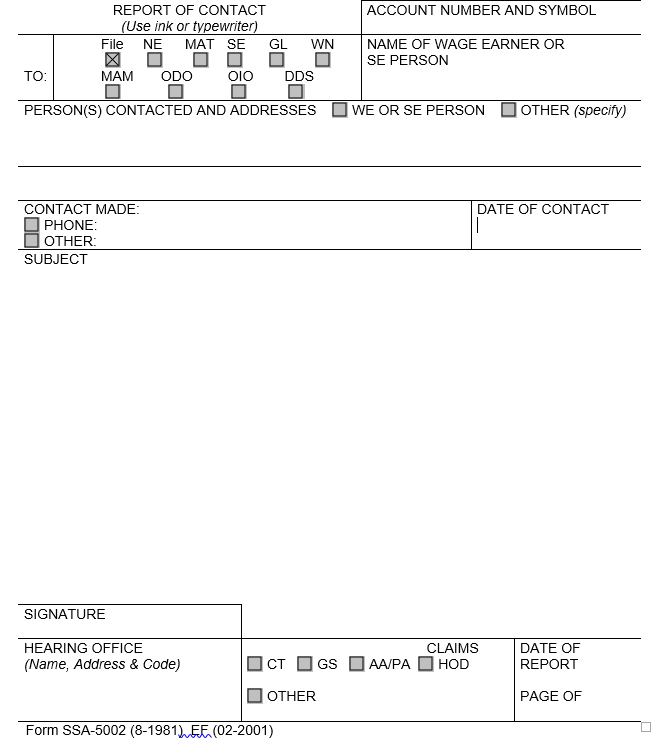
Use the ROC to document whether CEO contact was made, and, if successful, what transpired at the CEO. The DW can use the templates found in section 8 of this Guide to assist with completing the ROC following a CEO.
DW will then check the Parties of Interest screen to see if an interpreter may be needed or if the claimant is a child. If the claimant needs an interpreter, the DW should:
Contact the interpreter line at (1-800-200-7236) or (1-818-504-1296)
Tell the interpreter to hold, and then press the Conference soft key.
Then dial the claimant’s number, and after the claimant picks up, press the Conference soft key a second time.
Ask the interpreter to relay that you are calling the claimant from the Social Security Administration to gather some information about their claim for disability benefits.
DW should update the Parties of Interest languages section and the Scheduling & Hearing Held page of CPMS as applicable.
If the claimant is a child, the DW will conduct the CEO with the party of record who filed the claim on behalf of the child, or the claimant’s representative (Refer to the Represented Claimant Guide).
DW will determine whether the claimant had a prior prehearing development contact (PHDC). To do so:
View Section E of the Case Documents tab in eView for a ROC labeled “PHDC HELD,” or similar notation, and
Look for the Case Characteristic “PHDY” in the case entry in CPMS.
DW will then call the claimant from his or her agency issued Softphone at the number on file and proceed as directed below.
If the DW is unable to reach the claimant, the DW should leave a voicemail identifying himself or herself as set forth in the Introduction and Verification section below, and requesting that the claimant call back to discuss the claim as soon as possible.
DW should diary the case for seven (7) days, or sooner as workloads demand, and call the claimant again at the end of the diary period.
If the DW is unable to reach the claimant on the second attempt, the DW should deem the CEO unsuccessful and proceed as instructed in Section 8, below.
If contact is successful, proceed with the CEO as follows:
Introduction and Claimant verification:
[If the claimant was not called before the CEO to obtain electronic contact information]
“Good morning/afternoon. My name is _________________ and I am [position title] with the [hearing office location] in the Social Security Administration.
May I speak with ___________________?
As you may know, the coronavirus or COVID-19 pandemic has required us to change our business process. I am calling you today to discuss those changes. Do you have a few minutes to talk?” [Proceed to verification]
[If the claimant was called before the CEO to obtain electronic contact information]
“Good morning/afternoon. This is _________________ calling again from the Social Security Administration.
Is this ___________________?
As I previously stated in my email, I am following up with you today to discuss changes in our business process. Do you have a few minutes to talk?”
“For your security, I have to verify your identity before we begin.”
Verify the claimant’s identity consistent with agency policy. POMS GN 03340.015 and DI 39567.210.
Ask for complete first and last name, mailing address, last four digits of SSN, DOB, and pieces of information unique to the claimant, such as medical source(s), hospital name(s), or employment history.
Due to recent scamming attempts, claimants may request SSA employees to verify their identity. Please ensure that all contact with claimants is conducted on your agency issued Softphone as it will display the Social Security Administration on the caller ID. Additionally, you may recommend that the claimant call the hearing office main line and dial your direct extension to reach you.
Inform the claimant of the right to representation.
[If claimant had a prior PHDC, state the following]
“When we spoke with you on [PHDC date], we informed you that you have the right to obtain representation]. Do you now have an attorney or is anyone helping you with your disability case?”
[If the claimant says yes, tell him or her that we need the form SSA-1696/Appointment of Representative (or other signed, written notice of appointment), and that he or she should contact the representative to get the written notice of appointment that to us immediately. Inform the claimant that we cannot continue with the CEO in the absence of the representative, but that we will attempt to reschedule the CEO with the representative when we receive the form SSA-1696 (or other signed, written notice of appointment).]
[If no representative, state the following:]
“If you still want to get a representative, you should do so as soon as possible. Because you’ve been informed of your right to a representative, should you not have one on the day of your hearing, the ALJ may not grant a request to postpone your hearing to obtain a representative unless you provide a good reason. If you obtain representation, the hearing can go forward with a representative even if we have not yet received the written notice of appointment, but you will need to provide additional information about your intent to appoint the representative on the record during the hearing.”
[If no prior PHDC, state the following]
“Do you now have an attorney or is anyone helping you with your disability case?”
[If the claimant says yes, tell him or her that we need the form SSA-1696/Appointment of Representative (or other signed, written notice of appointment), and that he or she should contact the representative to get the written notice of appointment to us immediately. Inform the claimant that we cannot continue with the CEO in the absence of the representative, but that we will attempt to reschedule the CEO with the representative when we receive the form SSA-1696 (or other signed, written notice of appointment).]
[If the claimant does not have a representative, state the following:]
“You have the right to proceed without a representative. If you proceed without one, we will assist you with developing the record, including obtaining relevant evidence and the judge will question you at the hearing.
However, a representative can help you get and submit evidence, and can assist you at your hearing. Some representatives charge a fee, but there are also legal service organizations that may provide legal services without charge if you meet their requirements.
When you filed your request for hearing, we sent you an Acknowledgement letter that contained information on your right to representation and a list of organizations that provide legal services. Did you receive this information?” [If not, you may offer to recite the legal services on your local list to the claimant. You can also give them the Legal Services Hotline – XXX-XXX-XXXX. Please only provide your local Legal Services Hotline #.]
“If you still want to get a representative, you should do so as soon as possible. Because you’ve been informed of your right to a representative, should you not have one on the day of your hearing, the ALJ may not grant a request to postpone your hearing to obtain a representative unless you provide a good reason. If you obtain representation, the hearing can go forward with a representative even if we have not yet received the written notice of appointment, but you will need to provide additional information about your intent to appoint the individual on the record during the hearing.
Do you understand your right to representation?”
Inform the claimant that hearings will be conducted by telephone
[For case in RTS status prior to UNAP]
“Due to the current COVID-19 public health emergency, we are only conducting hearings by telephone at this time. The Administrative Law Judge assigned to hear your case will be conducting the hearing from his or her personal residence. The Administrative Law Judge will take every reasonable precaution to protect your personal information and to ensure your hearing remains private. In order for us to schedule your hearing, you will need to agree to a hearing by telephone. Do you agree to go forward with a telephone hearing?
[If yes,] We will send you a notice containing the date and time of your hearing. On the day of the hearing, we will call you at the number you have previously provided. [Confirm with the claimant the phone number we have on file and make any changes that the claimant provides.]
[If your supervisor informs you that the cases you are calling about will be scheduled less than 75 days out, state the following] “We generally must provide you with at least 75 days’ notice in advance of your hearing. Because we must schedule your hearing in less than 75 days, we cannot provide you with this advance notice. Do you agree to waive advanced notice of your scheduled hearing?”
[If claimant does not agree to a telephone hearing or 75 days’ notice]
“Since you have not agreed to a telephone hearing [or to waive 75 days’ notice], we cannot schedule your case for a hearing at this time. We will schedule your hearing once our offices reopen.” [DW should add the refusal in the ROC, proceed to the file review and evidence development section, and follow the steps at the end of this document, including adding the appropriate case characteristic (CVNC, CVTA, CVTD).]
[For case in SCHD status prior to UNAP]
“We scheduled you to appear at your hearing [choose in person or by video teleconferencing, as applicable]. Due to the current COVID-19 public health emergency, we are only conducting hearings by telephone at this time. The Administrative Law Judge assigned to hear your case will be conducting the hearing from his or her personal residence. The ALJ will take every reasonable precaution to protect your personal information and to ensure your hearing remains private. In order to proceed with the hearing on the scheduled date and time, you will need to agree to appear by telephone.
If you do not wish to conduct your hearing over the telephone, we will postpone your hearing to a future date. Due to COVID-19, however, we cannot predict when your hearing will be rescheduled. Do you wish to conduct your hearing over the telephone, or would you like us to postpone your hearing?” [Postponement is effective if the claimant verbally states that he or she wishes to postpone the hearing.]
[If claimant does not agree to a telephone hearing]
“Since you have not agreed to a telephone hearing, we must postpone your scheduled hearing at this time. We will schedule your hearing once our offices reopen. When the agency reschedules the hearing, we will mail an amended notice of hearing that includes the new date and time, at least 20 days before the date of the rescheduled hearing.” [DW should add the refusal in the ROC, proceed to the file review and evidence development section, and follow the steps at the end of this document, including adding the appropriate case characteristic (CVNC, CVTA, CVTD).]
When applicable, ask the claimant if he or she will waive the right to an amended notice of hearing mailed at least 20 days before the hearing
[For SCHD cases prior to UNAP, if claimant wants to proceed with the telephone hearing, and if waiver applicable]
“Because we are changing your hearing to a telephone hearing, we are required to mail you an amended notice of hearing at least 20 days before the date of your hearing. However, less than 20 days remain before the date of the hearings, so we cannot proceed with the hearing as scheduled unless you waive your right to an amended notice of hearing. If you do not waive the right to an amended notice of hearing, we must reschedule the hearing for a later date. Do you agree to waive your right to an amended notice of hearing?”
[If the claimant does agree] “On the day of the hearing, we will call you at the number you have previously provided.” [Confirm with the claimant the phone number we have on file and make any changes that the claimant provides.]
[If the claimant does not agree, DW should add the refusal in the ROC, proceed to the file review and evidence development section, and follow the steps at the end of this document, including adding the appropriate case characteristic (CVNC, CVTA, CVTD).]
Discuss the electronic file with the claimant or walk the claimant through the exhibits of record as applicable
[If the claimant was called before the CEO to obtain electronic contact information]
“I previously called you and you provided your email address so we could send you an electronic copy of the evidence we have in your case. Did you receive the email we sent you and have an opportunity to review the evidence?
[If so, ask the claimant if he or she has any questions about the evidence in the file, and inform the claimant that this is the evidence that the Administrative Law Judge will use to decide the case.]
[If the claimant did not receive the email or did not review the evidence, proceed to the evidence walkthrough below.]
[If no email contact was previously established, but the record reflects the claimant received a CD]
“Our records show that you received a CD containing the evidence in your file on xx/xx/xxx.” [Verify that the claimant has received a CD. If so, ask the claimant if he or she has any questions about the evidence in the file, and identify any new exhibits that have been added to the file.]
[If the claimant has not received a CD or email, proceed with the below information and walk the claimant through the evidence in the file.]
“Due to the COVID-19 public health emergency, we are currently unable to provide you with a CD containing the evidence in your claims file. Our offices are also currently closed, so you cannot visit one of our offices to review the evidence in person, as would normally be the case. For these reasons, I will now walk you through the evidence in your claims file.
Our claims file divides the evidence in your case file into five sections, comprised of sections A, B, D, E, and F. I’ll begin with Section A. If you have any questions as I proceed through the evidence, please let me know and I will answer any questions if possible.
Section A contains documents explaining any past decisions you have received from the Social Security Administration regarding your claim. [List the total number of exhibits in section A, then walk through each exhibit in Section A, stating the title and providing a brief description of each exhibit].
Section B contains the jurisdictional and procedural history of your case, including certain notices we have sent you about the status of your case. [List the total number of exhibits in section B, then walk through each exhibit in Section B, stating the title and providing a brief description of each exhibit].
Section D contains our records of your wage and earnings reports. [List the total number of exhibits in section D. Do not walk through each exhibit, state the title, or provide a brief description of each exhibit].
Section E contains the documents we send you requesting additional information, as well as any forms that we asked you to complete. [List the total number of exhibits in section E, then walk through each exhibit in Section E, stating the title and providing a brief description of each exhibit].
Finally, section F contains all of the medical records in your claims file. [List the total number of exhibits in section F, then walk through each exhibit in Section F, stating the title and providing a brief description of the exhibit].
[After you have completed a walkthrough of the evidence] The evidence in your claims file is what the Administrative Law Judge will consider when issuing a decision in your claim for disability benefits.”
Inquire as to any outstanding medical evidence or recent treatment
[If a prior PHDC]
“As we stated when we [called you on xx/xx/xxxx], we will assist you with developing the record, including obtaining relevant evidence. We want you again to be aware that due to the COVID-19 pandemic, we may not be able to timely obtain the evidence you identify; however, we will not issue a decision until we have completed our efforts to help obtain the evidence that you identify.
[Ask the following questions:]
Are you currently working?
Next, we need to renew your authorization to request your medical records.
You completed an authorization when you filed your claim, and we need to update that authorization - I can reauthorize over the phone. I will ask you to acknowledge that you have read the SSA-827 (Authorization to Disclose Information to the Social Security Administration), and confirm your intent to sign this form. It will be used to request all of your medical records and other information.
Do you understand that the SSA-827 that you have read will be used to request all of your medical records and other information related to (your or claimant’s name) ability to perform tasks?
Do you agree to authorize disclosure of your information to SSA?”
[If the claimant agrees, DW can create a new e827 authorization through the case documents tab in eView. First, select the ‘lock’ the case button in the top right corner, then select the e827 tab at the bottom, and select “telephone” as appropriate. The e827 should propagate in the Disability Related Development (Blue section of eView). For reference, the publicly available 827 form is accessible on the Social Security website, at Authorization to Disclose Information to the Social Security Administration (SSA).]
[Note: If the claimant indicates that he or she has not reviewed the form, or answers negatively to either of the above two questions, add a note in the ROC, and proceed with the remaining steps in this guide]
“Taking a look at your file, I see we have received no medical records since [DATE]_________.
Ask questions to determine what evidence is needed, such as: Have you been to the hospital since then? Who are your treating physicians? Do you see a psychiatrist, therapist, or psychologist? Etc. Be specific and obtain provider names and dates of treatment.”
[If NO prior PHDC]
“In order to decide your case, we want your file to reflect all of your updated medical records. Please make sure that we have all of your records prior to your hearing.
Having a complete file before the hearing prevents delays. With that in mind, you must generally inform us about, or submit written evidence, including your medical records no later than five business days before the hearing. We are mindful and acknowledge that the COVID-19 pandemic may give rise to unusual, unexpected, or unavoidable circumstances beyond your control that prevent you from meeting such a deadline, however. If you need to inform us about or submit written evidence but you miss the five-day deadline, please let us know that and tell us why you missed the deadline.
[Ask the following questions:]
Are you currently working?
Next, we need to renew your authorization to request your medical records.
You completed an authorization when you filed your claim, and we need to update that authorization - I can reauthorize over the phone. I will ask you to acknowledge that you have read the SSA-827 (Authorization to Disclose Information to the Social Security Administration), and confirm your intent to sign this form. It will be used to request all of your medical records and other information.
Do you understand that the SSA 827 that you have read will be used to request all of your medical records and other information related to your ability to perform tasks?
Do you agree to authorize disclosure of your information to SSA?”
[If the claimant agrees, DW can create a new e827 authorization through the case documents tab in eView. First, select the Edit ‘lock’ case button in the top right corner, then select the e827 tab at the bottom, and select “telephone” as appropriate. The e827 should propagate in the Disability Related Development (Blue section of eView).
[Note: If the claimant indicates that he or she has not reviewed the form, or answers negatively to either of the above two questions, add a note in the ROC, and proceed with the remaining steps in this guide]
“Taking a look at your file, I see we have received no medical records since [DATE]_________.
Ask questions to determine what’s needed, such as: Have you been to the hospital since then? Who are your treating physicians? Do you see a psychiatrist, therapist, or psychologist? Etc. Be specific and obtain provider names and dates of treatment.
We will assist you with developing the record, including helping to obtain evidence you have identified. Please be aware that due the COVID-19 pandemic, we may not be able to obtain the evidence you identified prior to the hearing; however, we will not issue a decision until the evidence is received.
Is there anything else that you have not informed us about?”
Reminders and Best Practices [Not to be read to the claimant, for internal use only]
Do not provide the claimant with advice. If the claimant tries to ask for advice, you can answer with the following: “This is an issue/fact on which the judge will have to make a determination. You may address this issue at your hearing.”
Do not communicate with the claimant in an adversarial manner.
If a claimant becomes abusive or discourteous, end the call and contact your supervisor.
Keep your discussion focused on issues of the telephone hearing, representation, current work activity, and medical evidence.
It is useful to have Google open when verifying medical provider names and medical addresses – Google the name/pieces of address/zip code that the number holder remembers for the medical provider and then confirm the addresses with the claimant, then cut and past the address into the ROC.
It may be helpful to include the medical provider’s phone number as well if available.
If your Softphone has technical issues, do not use your personal phone. Use the guidance provided by OESSI and contact your supervisor.
After the CEO contact has concluded, take the following steps as appropriate
If applicable, DW should create a Development in CPMS assigned to the supervisor, to communicate necessary development as indicated in the ROC. To create a Development item:
In CPMS Development screen, select Add New Development

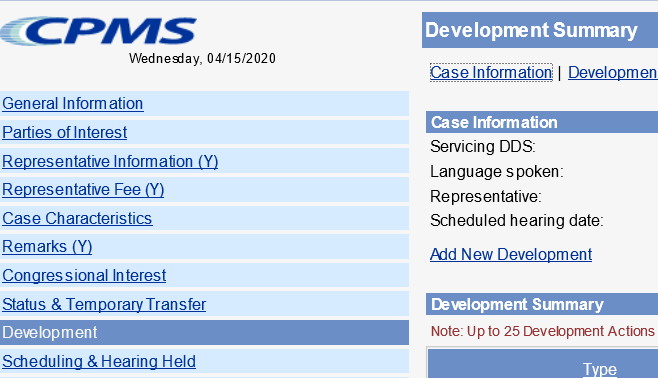
Development group: Other
Type: Unsolicited Development
Place development in your supervisor’s name

Select the radial button that states Request has not been sent, click Save

DW should add the appropriate case characteristic (CVNA, CVTA, CVNC).
DW should copy/paste the completed ROC Template into the ROC in the SUBJECT section, then send to eView by selecting the ADD-INS button, then Send to eFolder, then SEND.
If contact was unsuccessful, use the following ROC format:
I did not reach the claimant for a COVID Enhanced Outreach.
Provide reason(s) for unsuccessful attempt:
Confirm if voicemail(s) left:
Call(s) attempted on (Date(s)):
If contact was successful, use the following ROC format:
I reached the claimant for a COVID Enhanced Outreach Conference on the date of this ROC.
During the CEO, I:
Verified the claimant's contact information
[If applicable] Inquired as to whether the claimant was working. (Negative unless noted in the ROC)
[If applicable] Provided the claimant information regarding their Right to Representation and the claimant affirmed understanding of that information
[If applicable] Provided the claimant with contact information for representatives / representative organizations
[If applicable] Informed the claimant that Agency may not grant a postponement to obtain representation absent good cause
[If applicable] Obtained an e827
Informed the claimant that hearings will be conducted by telephone
[If applicable] Obtained waiver of 75-day advance notice for RTS cases
[If applicable] Obtained waiver of 20-day advance notice for SCHD cases
Informed the claimant of their responsibility to obtain information, including updated medical evidence, and provide it to the hearing office as soon as possible, but at least 5 business days prior to the scheduled hearing date
I also asked the claimant about any updated medical sources. They reported the following:
(Include (1) Clinic or Doctor's name; (2) Address; (3) When to request records from)
If the CEO contact was successful and the claimant agreed to a telephone hearing, DW will create a brief outline and associate with the case.
Follow the below steps for the Brief Outline and On-the-Record Review





Select the appropriate case by clicking the claimant’s name.
In the case entry, click the “HACPS Case Analysis” link at the top right of the screen to launch the HACPS Case Analysis application.

![]()
Select “Case Notes” within the Open Case Analysis box.
If the CEO contact was successful and the claimant agreed to a telephone hearing, use the “General Notes” feature in Case Analysis to add a “General Note” that contains a brief outline of observations and any relevant issues that came up during the CEO.


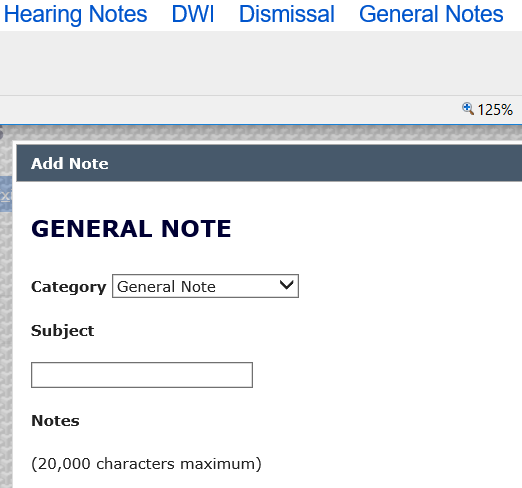
In the General Note, include the following information:
The claimant was informed that the hearing would take place by telephone and the hearing would be postponed if he or she did not agree to waive the 20-day notice requirement.
Document whether verbal waiver was obtained.
The claimant was advised of the right to representation.
A description of the claimant’s current work activity, if any.
Any recent medical treatment identified by the claimant that may need to be obtained.
Any observations that might be helpful for a future reviewer or adjudicator.
In any case assigned for a CEO, use the “General Notes” feature in Case Analysis to add an “OTR Review Note” that contains the analysis of the claimant’s file and recommendation as to whether or not a fully favorable decision is recommended. NOTE: This is a separate entry from the “Brief Outline” discussed above.


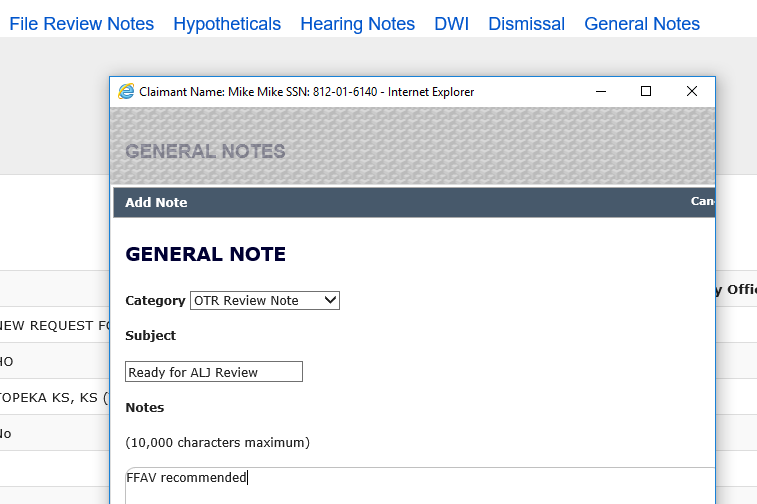
In eView, add queries to Section D of the Certified Electronic Folder (CEF), if necessary (A guide for adding queries to the CEF is available here):
Information/Certified Earnings Record System (ICERS)
Detailed Earnings Query (DEQY)
Summary Earnings Query (SEQY)
National Directory of New Hires, Wage, and Unemployment Query (NDNH)
To add queries in eView, click on the "Queries" hyperlink in the Case Documents tab, which will open a "Query Selection Screen." Select "View & Save to EF" in the Query Selection Screen and the query will appear under the queries section of the electronic file in eView.





NOTE: The DEQY on the “Query Selection Screen” in eView will automatically select Covered Details, Non-Covered Details, Pension, Special Wage Payment, and Employer Address. Additionally, run the DEQY covering the period beginning 15 years prior to the date of adjudication of the issue of initial entitlement or continuing disability, unless it is a title II only claim with a date last insured in the past. In those claims, run the DEQY covering the period beginning 15 years prior to the expiration of the claimant’s insured status.
Lock the case, then select the queries and move them to the D Section.





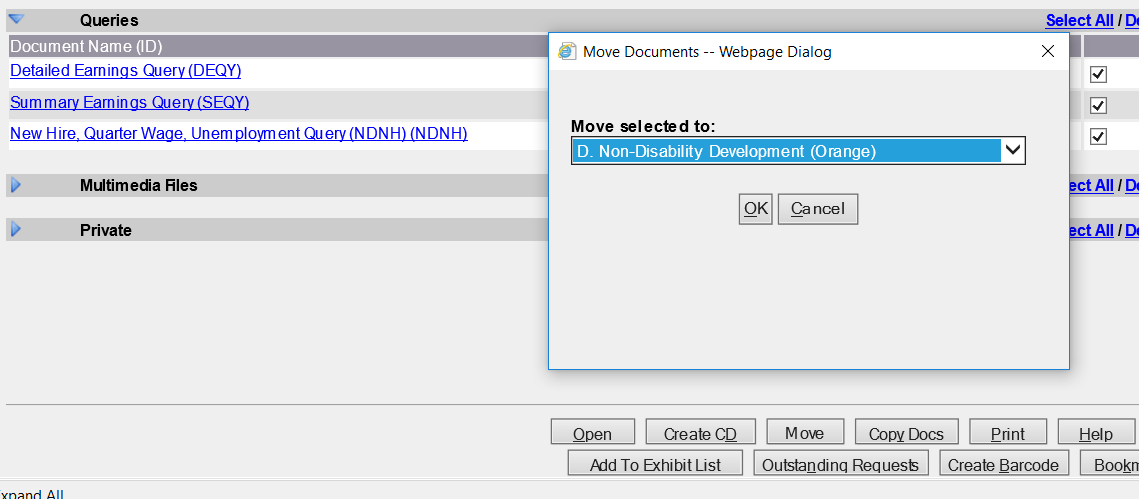
For instructions on how to upload the ICERS query to eView, refer to “Push to eView” Template User Guide.
Review the medical evidence and other evidence of record to evaluate whether a preponderance of the evidence supports a fully favorable decision.
Ensure the claimant’s wage and earnings records do not reflect disqualifying substantial gainful activity.
In Title II cases, note the claimant’s date last insured (DLI) or other date relevant to eligibility.
Review the claimant’s medical records in Section F (and Section E, as needed) for evidence that may support further review by a Senior Attorney related to whether the claimant has a severe impairment that meets a listing at Step 3 of the sequential evaluation process.
If the evidence does not support a potential OTR fully favorable decision at Step 3, perform a cursory review of the evidence related to past relevant work and other work.
Considering the claimant’s age, education and work experience, without proposing a residual functional capacity, note if the evidence may support a finding that:
Applying the special medical-vocational profiles results in an inability to make an adjustment to other work;
Directly applying a grid rule in the medical-vocational guidelines results in a finding of disability at Step 5; or
Using the medical-vocational guidelines as a framework results in a finding of disability at Step 5.
Once the CEO and OTR have been completed, assign the case in the appropriate status based on the outcome of the case.
For cases previously in RTS prior to UNAP, move from UNAP to RTS and assign to the supervisor.
For cases previously in SCHD prior to UNAP:
Where the claimant has agreed to a telephone hearing, go into the Scheduling & Hearing Held Summary and click the “Remove from Hold” link. It will automatically update the case back to SCHD status.
Where the claimant has NOT agreed to a telephone hearing, assign to the supervisor in UNAP, with an alert that the hearing needs to be postponed.
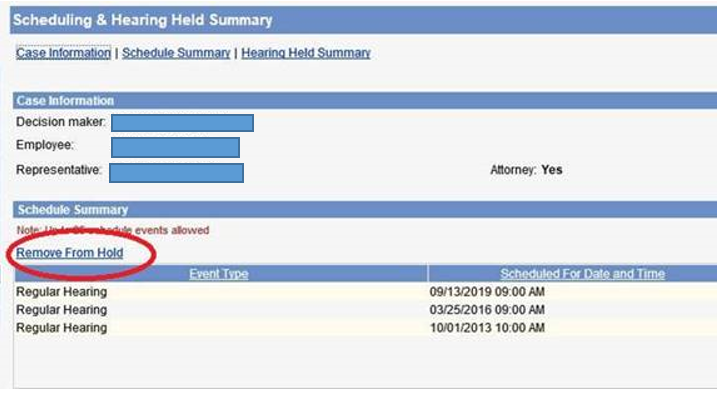
Add the appropriate case characteristic based on the outcome of the CEO:
CVTA – Telephone hearing accepted
CVTD – Telephone hearing declined
CVNC – Unable to make contact with the claimant

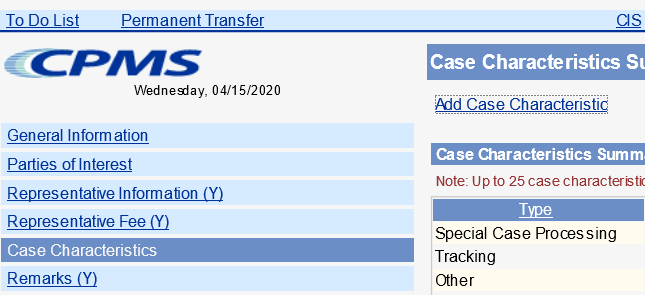
| File Type | application/vnd.openxmlformats-officedocument.wordprocessingml.document |
| Author | Higgins, Michael |
| File Modified | 0000-00-00 |
| File Created | 2021-01-12 |
© 2025 OMB.report | Privacy Policy
